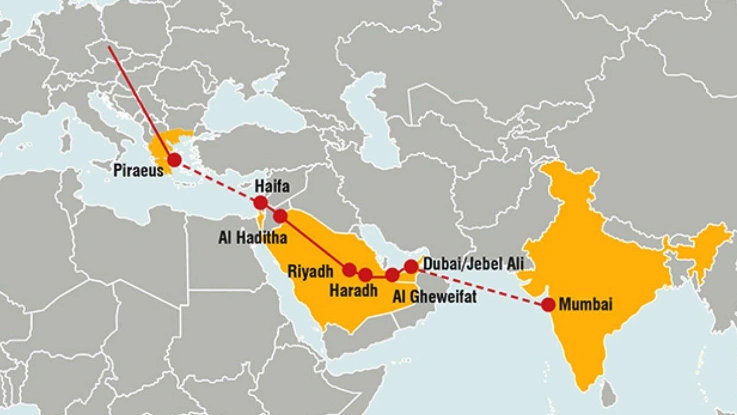The IMEC Corridor will increase integration between Asia and Europe. Poland has a chance to include the Baltic region

 By Marek Grzybowski
By Marek Grzybowski
World leaders initiated the India-Middle East-Europe economic corridor perceived as contradictory to China’s New Silk Road BRI. IMEC’s goal is to promote economic development through economic integration between Asia, the Gulf and Europe.
During the G20 summit in New Delhi, an initiative was taken to build a new trade route. The creation of the India – Middle East – Europe Economic Corridor (IMEC – India – Middle East – Europe Economic Corridor) was declared.
The Memorandum of Understanding (MoU) was signed by the governments of India, Middle East countries, Europe and the United States. Its signatories do not hide that this initiative is intended to be an alternative to one of the corridors developed by China as part of the Belt and Road Initiative (BRI). Its signatories hailed this cooperation as a significant milestone in “world economic and political dynamics.”
The creation of this transcontinental transport corridor was supported by the Kingdom of Saudi Arabia, the Republic of India, the United Arab Emirates (UAE), the French Republic, the Federal Republic of Germany, the Italian Republic and the United States of America.
India – Middle East – Europe Economic Corridor
– The aim of IMEC is to support economic development by supporting economic connectivity and integration between Asia, the Persian Gulf and Europe – its initiators say in a press release.
The organizers of the project point to the key features of the India-Middle East-Europe economic corridor (IMEC). There will be two corridors. IMEC will consist of two separate corridors. The Eastern Corridor connecting India with the Persian Gulf and the Northern Corridor connecting the Persian Gulf with Europe.
Transport will rely primarily on a rail network designed to provide reliable and cost-effective cross-border rail transport. This network will complement existing sea and road routes.
Railway and IT network with a hydrogen pipeline
IMEC is intended to provide better connectivity. The planned corridor will not only involve rail transport. Infrastructure will be built along the corridor to provide power supply through energy networks.
An IT network will also be built. Pipelines for the transmission of clean hydrogen are also planned. it is believed that “This will not only secure regional supply chains, but also improve the regions’ commercial accessibility and facilitate trade operations.
The social goal that will be achieved by economic unity and job creation is also important. The goal of IMEC is to increase economic efficiency, reduce costs and support economic unity among the participating countries.
According to those signing the agreement, “It will create employment opportunities and contribute to achieving the global goal of reducing greenhouse gas emissions.”
An important part of the agreement are activities that reduce the negative impact on the environment and society. It is emphasized that “Great emphasis will be placed on adapting the project to sustainable development goals and thus reducing the negative impact on the environment and society. IMEC also aims to transform the economic environment by seamlessly integrating Asia, Europe and the Middle East, creating a corridor for trade and investment. This activity is referred to as “Transformational Integration.”
Strategic response to BRI
The development is also seen as a strategic response to China’s Belt and Road Initiative (BRI), which has expanded China’s influence in Asia, Africa and Europe. The launch of IMEC highlights the global shift in economic and geopolitical power, and India is at the heart of this strategic corridor.
The project is open to extension to other countries, such as Greece. Poland could also join the initiative, as it is intensively expanding its port infrastructure. This is a chance to get involved in an ambitious and promising venture.
Its primary goal is to create a solid transit network. It is intended to cover shipping routes between India and Saudi Arabia. This will be strengthened with the mentioned rail links from the UAE and potentially extending to Jordan.
Important ports in the IMEC corridor
From Jordan, the routes will be extended by sea from Turkish or Israeli ports. The Port of Dubai, and in particular the Jebel Ali Port, can play a key role in connecting the United Arab Emirates with India. The connectivity plan covers sea routes between India and Dubai, likely via Kandla and JNPT ports.
Mundra port in Gujarat is also being considered. The port of Dubai is likely to serve as the starting point for a proposed rail link that would connect the United Arab Emirates with Saudi Arabia, Turkey, Israel and Europe.
Von der Leyen described the initiative as “much more than just rail or cable. It is an ecological and digital bridge connecting continents and civilizations,” The Guardian reported.
To increase trade between India and Europe by 40%
The project is intended to increase trade between India and Europe by 40% and help normalize relations between Israel and the Persian Gulf countries, which is what the Biden administration is striving for (the project was signed before the Hamas rocket attack on Israeli territory – Ministry of Economy).
– We believe that the project itself is bold and forward-looking, but the vision behind it is equally bold and transformative, and we will see it replicated in other parts of the world, said Jake Sullivan, Biden’s national security adviser.
Following his thought, it should be noted that we lack such corridors leading through Polish ports. And Via Baltica could easily connect the economic zones of the

